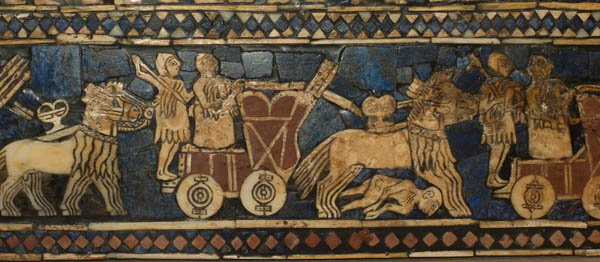
The "Royal Standard of Ur", c.2500 BC from the Royal Burials at Ur in the Sumerian capital in Mesopotamia (WA 121201).
Ur was an ancient city of the Sumerians in southern Mesopotamia, located near the mouth (at the time) of the Euphrates and Tigris rivers on the Persian Gulf and close to Eridu. Because of marine regression, the remains are now well inland in present-day Iraq, south of the Euphrates on its right bank, and named Tell el-Mukayyar, near the city of Nasiriyah south of Baghdad.
The Royal Cemetery of Ur was excavated by Leonard Woolley in the 1920s and 1930s, although there is no direct evidence to indicate that the men and women in the tombs were Kings or Queens. The tombs held a mass of finely crafted goods; harps and lyres, drinking cups, gaming boards and jewellery in gold and silver. The elite bodies were surrounded by other bodies, possible indicating a ceremonial sacrifice of retainers but later burials in close proximity to the elite burials is equally possible.
It was originally thought to be a standard which was mounted on a pole but it could actually be a musical instrument of some kind. It is decorate on each side with mosaic scenes made form shell, red limestone and lapis lazuli set in bitumen. On one long-side are scenes of war and on the other scenes of peace.
